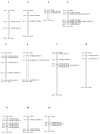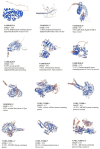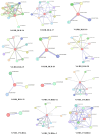Salicylic Acid-Induced Expression Profiles of LRR and LRR-RLK Candidate Genes Modulate Mungbean Yellow Mosaic India Virus Resistance in Blackgram and Its Two Wild Non-Progenitors
- PMID: 39771299
- PMCID: PMC11678391
- DOI: 10.3390/plants13243601
Salicylic Acid-Induced Expression Profiles of LRR and LRR-RLK Candidate Genes Modulate Mungbean Yellow Mosaic India Virus Resistance in Blackgram and Its Two Wild Non-Progenitors
Abstract
Blackgram is an important short-duration grain legume, but its yield is highly affected by various stresses. Among biotic stresses, yellow mosaic disease (YMD) is known as a devastating disease that leads to 100% yield loss under severe conditions. The cultivated lines possess resistance, but exploring more diverse sources of resistance may be useful for pyramiding to improve the durability of said resistance. Some wild Vigna species have potentially demonstrated a high level of resistance. R-genes, including gene families of leucine-rich repeats (LRRs) and leucine-rich repeat receptor-like kinases (LRR-RLKs), are known for modulating the resistance in plants against various biotic stresses. The first comprehensive analysis of the LRR and LRR-RLK gene families in mungbean is reported in the present study. A total of forty-six candidate genes were identified and grouped into eight clades. Protein motif analysis showed that the "Pkinase domain" and "LRR domains" were conserved in most of the R-proteins. The expression of candidate genes viz. VrNBS_TNLRR-8, VrLRR_RLK-20, VrLRR_RLK-17, and VrLRR_RLK-19 demonstrated significantly up-regulated expression upon YMD infection in control and salicylic acid-primed (SA-primed) plants. The analysis provides insight into the diversity and robust candidate genes for functional studies modulating YMD resistance altered by salicylic acid.
Keywords: LRR-RLK; R-genes; YMD; gene expression; qRT-PCR; salicylic acid.
Conflict of interest statement
The authors declare no conflicts of interest.
Figures












Similar articles
-
Genome-Wide Identification of LRR-RLK Family in Saccharum and Expression Analysis in Response to Biotic and Abiotic Stress.Curr Issues Mol Biol. 2021 Oct 18;43(3):1632-1651. doi: 10.3390/cimb43030116. Curr Issues Mol Biol. 2021. PMID: 34698114 Free PMC article.
-
Genome-wide identification, characterization and expression analysis of populus leucine-rich repeat receptor-like protein kinase genes.BMC Genomics. 2013 May 10;14:318. doi: 10.1186/1471-2164-14-318. BMC Genomics. 2013. PMID: 23663326 Free PMC article.
-
Duplication and Divergence of Leucine-Rich Repeat Receptor-Like Protein Kinase (LRR-RLK) Genes in Basal Angiosperm Amborella trichopoda.Front Plant Sci. 2016 Dec 23;7:1952. doi: 10.3389/fpls.2016.01952. eCollection 2016. Front Plant Sci. 2016. PMID: 28066499 Free PMC article.
-
Yellow Mosaic Disease (YMD) of Mungbean (Vigna radiata (L.) Wilczek): Current Status and Management Opportunities.Front Plant Sci. 2020 Jun 24;11:918. doi: 10.3389/fpls.2020.00918. eCollection 2020. Front Plant Sci. 2020. PMID: 32670329 Free PMC article. Review.
-
Receptor-like Kinases (LRR-RLKs) in Response of Plants to Biotic and Abiotic Stresses.Plants (Basel). 2022 Oct 10;11(19):2660. doi: 10.3390/plants11192660. Plants (Basel). 2022. PMID: 36235526 Free PMC article. Review.
References
-
- MoAF&W, DES, Agricultural Statistics Division. [(accessed on 23 February 2024)];2022 Available online: https://desagri.gov.in/document-report-category/agriculture-statistics-a...
-
- Kumari N., Aski M.S., Mishra G.P., Roy A., Dikshit H.K., Saxena S., Kohli M., Mandal B., Sinha S.K., Mishra D.C., et al. Development of infectious clones of mungbean yellow mosaic India virus (MYMIV, Begomovirus vigna radiata indiaense) infecting mungbean [Vigna radiata (L.) R. Wilczek] and evaluation of a RIL population for MYMIV resistance. PLoS ONE. 2024;19:e0310003. doi: 10.1371/journal.pone.0310003. - DOI - PMC - PubMed
-
- Tripathi A., Singh C.M., Kumar M., Purwar S., Mishra A., Kumar D., Singh N.P. Identification of potential sources of mungbean yellow mosaic India virus resistance in black gram (Vigna mungo) and expression of antioxidants and R-genes modulating resistance response in cultivated and its two wild relatives. Plant Breed. 2023;142:668–681. doi: 10.1111/pbr.13122. - DOI
LinkOut - more resources
Full Text Sources

